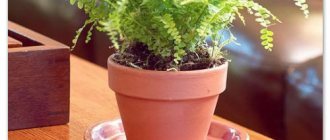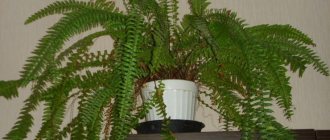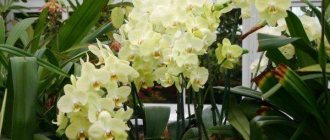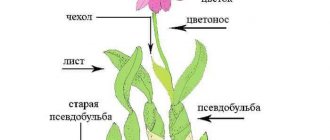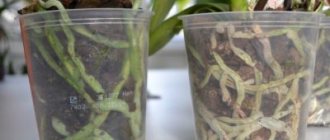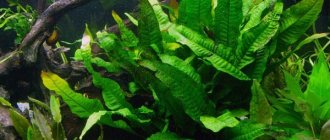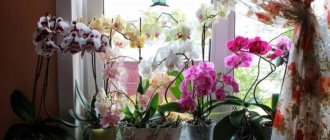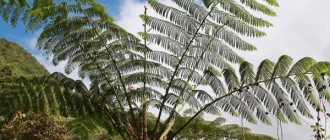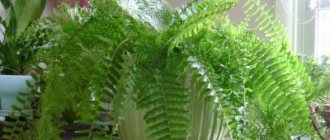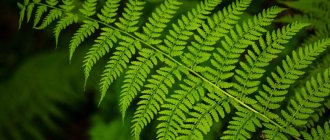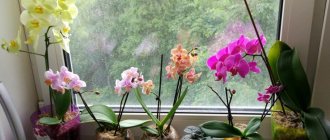Description of fern-like plants
What is a fern, there are different versions. Scientists believe that these are direct descendants of the most ancient plants - rhinophytes. In the process of evolution, the structure of ferns has become more complex; why ferns are classified as higher plants does not surprise anyone. It confirms:
- cyclical development of plants;
- developed vascular system;
- adaptability to the terrestrial environment;
Fern in nature
By definition, a fern is a perennial plant that belongs to the genus of spore-bearing plants. To the question about a fern: is it a shrub or a herb, you can answer in the affirmative in both cases. Sometimes it is also a tree.
Additional Information. When describing ferns, one cannot help but recall their varied colors, which provide aesthetic pleasure. These plants often become a real decoration of areas. Their undoubted advantage is resistance to diseases and pests.
Important! As you know, ferns do not bloom, but in Slavic mythology, the fern flower became a symbol of eternal love and happiness. On the night of Ivan Kupala, lovers search in vain for a mythical flower.
Transplanting seedlings
Fern seedlings do not grow evenly; the formation of roots on some specimens is delayed. Therefore, seedlings without roots are transplanted separately.
New containers with soil are prepared for them, the same as for sowing spores. Specimens without roots are placed on top of it and moistened with a spray bottle. Leave it there until the roots grow.
Specimens with a developed root system are grown to 2-2.5 cm and transplanted into separate cups. They are filled with the same soil mixture as for sowing with the addition of leaf soil.
Young seedlings are treated with epin solution and covered with film. Within 2 weeks, the seedlings take root and begin to grow. All this time it needs to be regularly ventilated and fed with a special solution for ferns. After 2-3 weeks, the ferns are transferred to individual containers.
Biological classification of ferns
Types of ferns - indoor and house plants
The sheer number of fern species makes their classification difficult. Such attempts were made by ancient scientists. The proposed schemes are often inconsistent with each other. The basis for the classification of modern ferns is the structure of the sporangium and some morphological characters. All varieties are divided into ancient and modern.
The division of ferns includes the following seven classes of vascular plants, both extinct and modern:
- Aneurophytopsida are the oldest primitive group.
- Archaeopteridopsida are also ancient representatives that resembled modern conifers.
- Cladoxylopsida - there are versions that this group represents a blind branch of evolution.
- Zygopteridopsida (Zygopteridopsida or Goenopteridopsida) are a transitional group to modern species.
- Ophioglossopsids or grasshoppers (Ophioglossopsida) are modern ferns.
- Marattiopsida are perennial plants of small and large forms.
- Polypodiopsida (Polypodiopsida - perennial or less often annual plants of different sizes). They are divided into three subclasses: Polypodiidae, Marsileidae, Salviniidae.
History of fern plant species
The history of ferns began in the era of dinosaurs - 400 million years ago. In the favorable warm and humid climate of tropical forests, ferns dominated the Earth. Some species reached 30 m in height. Over time, climatic conditions have changed dramatically. How many natural disasters had to happen for such giants as dinosaurs and tree ferns to disappear.
Reproduction of ferns - diagram and description
With all the diversity of modern ferns, they are very different from the most ancient plants, inferior to them in size and variety of shapes. But even today this is the largest group of spores - 300 genera and more than 10 thousand species. Ferns have become widespread due to their ecological plasticity and amazing reproductive characteristics.
Important! Climatic conditions favorable for ferns today remain in the tropics and subtropics, where tree ferns reach 20 m.
How long do ferns live?
How does the life cycle of a fern go - stages of development and reproduction
There is no clear answer to the question of how long ferns can live. It depends on the place and care (if it grows at home or in the garden). Membership of the species also plays a role. In temperate climates, when cold weather sets in, the upper part of the plant immediately dies off, but in tropical conditions the bush can grow for many years in a row.
However, the roots, which are adventitious, are renewed every 4 years, and the rhizome increases life expectancy in this case to a whole century. It is the powerful root system that allows the plant to survive and adapt to changing conditions.
Plant nutritional features
Ferns are plants that feed through roots and leaves. They absorb important microelements and water from the ground. Leaves are involved in photosynthesis. Thus, sugar and starch are obtained, which are required for the functioning of all organs of the fern.
Prevalence in nature, examples of species
What fertilizer is needed for dracaena - choice
When and where ferns grow depends on the warmth and humidity of the area. The habitat of ubiquitous plants can be:
- lower and upper tiers of forests;
- swamps, rivers and lakes;
- ravines and damp meadows;
- rock crevices;
- walls of houses;
- roadsides.
Ostrich
In temperate latitudes you can find hundreds of herbaceous representatives of ferns. Brief overview of some types:
- Common bracken. Easily recognizable by its leaves in the shape of an open umbrella. Distributed in pine forests, suitable for consumption.
- Male shieldweed. A herbaceous plant with leaves up to 1.5 m in length, it is very rare. Shield extract is used in medicine as an anthelmintic.
- Female Kochedyzhnik. A large plant with gracefully shaped leaves.
- Common ostrich. Large beautiful fern. Due to long rhizomes it forms entire thickets. Used in landscaping areas. Boiled ostrich leaves are edible.
- Osmunda. A plant with a short rhizome and long shiny leaves native to East Asia and North America.
- Multi-row. Its leaves are dark green in color and arranged in rows.
Important! Bracken grows so quickly that its planting should be limited to various fences dug into the ground.
Suitable for home cultivation:
- Kostenets;
- Nephrolepis;
- Davallia;
- Asplenium;
- Dixonia;
- Pteris.
These plants wonderfully decorate your home interior. The Junior variety with corrugated leaves is very beautiful.
Home plant
Interesting Facts:
- Hecystortheris pumila and Azolla cariliniana are the shortest plants. Their length does not exceed 12 mm.
- Epiphytes thrive on trees and vines.
- In mountainous areas you can find Venus hair - an amazing plant with beautiful openwork leaves.
- The tree-like trunks of large ferns are used as building material in the tropics.
- Marsilea quadrifolia thrives underwater.
- Dicranopteris has leaf petioles of metallic strength.
Rare species of ferns:
- Crested shieldweed;
- Phegopteris binding;
- Brown's multi-row;
- Asplenia wall;
- The grove is multipartite.
- The Salvinia floating fern is listed in the Red Book of Belarus.
Important! Plants with beautiful leaves have decorative value and are often used in landscape design and in the preparation of floral compositions.
Analysis of the structure of fern plants
The ancestors of fern plants had a primitive structure. In the process of evolution it has become more complex.
Stems
The stem of ferns is underdeveloped and small in size. It is called a rhizome. Of course, tropical ferns with woody stems are an exception. The climbing rhizome can spread over long distances.
Leaves, fronds
The fern leaf is much more massive than the stem. They are not quite ordinary, they have distinctive features of structure and growth, and various shapes. More often they are dissected and feathery. Fronds are the name given to the leaves of a fern. The leaf petiole is attached to the underground part of the stem - the root or rhizome. Looking at them, it is difficult to understand where the stem ends and at what level the leaf begins. An interesting feature of the frond is its growth at the top, which is a curled and gradually unfolding curl in the shape of a snail.
Vaii
Leaf development begins in the buds underground and lasts up to two years. Only in the third year can they appear above the ground. Due to apical growth, fronds of ferns reach very large sizes.
In most plants, fronds participate in the process of photosynthesis, vegetation, and at the same time in the formation of spores. Spores appear in sori, which are located on the underside of leaves in the form of single or group tubercles.
Root system
The root system consists of a powerful rhizome and numerous adventitious roots. Conductive tissue on the stem and roots absorbs water and moves it through vascular bundles to the leaves.
Reproductive organs
The life of a fern is divided into two cycles: a long asexual cycle - sporophyte and a short sexual cycle - gametophyte. The reproductive organs of ferns, sporangia, where spores are located, are located on the lower part of the leaves. Ripe spores spill out from the bursting sporangium and are carried by the wind far from the mother plant. Some scientists compare sporulation with the flowering of other plants.
Of the huge number of spores, only a part survives. The sexual phase begins when the spore germinates under favorable conditions into a haploid germ (gametophyte), which looks like a green heart-shaped plate several mm in size. On the underside of the prothallus, female and male genital organs - antheridia and archegonia - are formed. The eggs and sperm formed in them fuse in wet weather, and a zygote is formed, from which the embryo of a young plant develops - a sporophyte.
The plant can also reproduce vegetatively, when brood buds form on the stems and roots. This is important for amateur gardeners who grow certain species on their plots.
Important! It has been noticed that beautiful rare species reproduce only by spores.
Sexual reproduction and its features
To propagate ferns yourself at home, you need to collect spores that have been freed from the shell and sow them in the right place. This area should be well moistened. The condition for the successful conception of a new plant is a high level of humidity.
For cultivation, it is recommended to use a mixture of peat, sterilized soil and charcoal in a ratio of 8:2:1, respectively. The resulting mixture is filled into a small pot almost to the top, then it is compacted well and sprinkled with brick chips. Stones are scattered into this crumb. The top of the pot is tightly covered with transparent glass. The entire structure is placed in a pan with settled water. Growing temperature 21 degrees. The place should be dark.
The first shoots appear after a month, and after another two, the fertilized small ferns sprout their first leaves.
Comparison with other herbaceous plants
Pteridophytes are ferns, horsetails and mosses. They all reproduce by spores and have a common origin.
Ferns have characteristic distinguishing features from other herbaceous plants:
- They differ from algae in their rhizomes and complex leaves.
- In mosses and ferns, alternating generations of gametophyte and sporophyte occur. In mosses the gametophyte predominates, in ferns the sporophyte predominates. The presence of conducting tissue in the form of vascular bundles makes representatives of fern-like plants more adapted to a terrestrial lifestyle.
- Unlike flowering plants, they reproduce by spores and do not bloom.
Due to its rich chemical composition, fern has beneficial properties for people. Used for medicinal purposes and in cooking, suitable for pickling. Traditional medicine also did not ignore wonderful plants.
